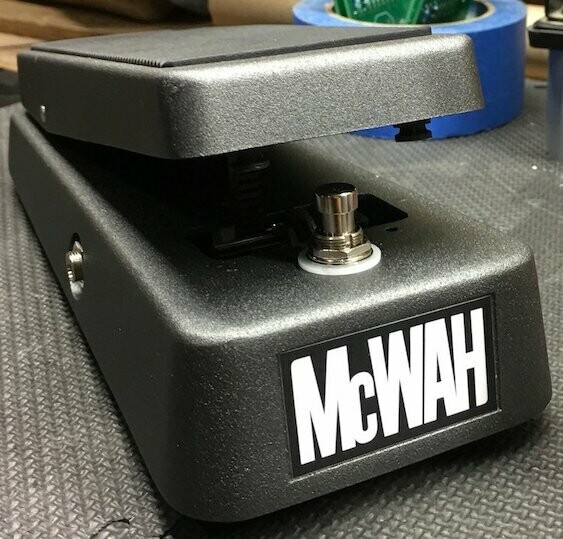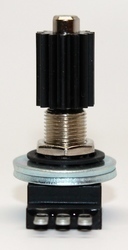McWah-2B - Made to Order (In a Queue)
*** Update 12/8/2022: After ten years, we've decided to increase the cost of the pedal by 10%. Tangential, but related: we've received messages and seen pages where used/older McWah pedals are selling on 3rd party sites, for 900+ USD. A compliment, but still outrageous. None the less, you will be able to get a brand new one here, for less than half of those used prices. ***
*** UPDATE 11/1/2022: After almost three years of enclosure sourcing problems, we've finally received more! We bought all the remaining NOS stock that was found in our original supplier's warehouse. **
How the McWah came to be, was a carefully studied and concerted effort: with a sole mission of staying “true” to characteristic original vibes that we've all come to expect from an original classic wah while re-creating the necessary bite, warmth, and feel that a good modern wah must have.
In the prototyping days (~2003) we acquired several different wahs from various manufactures: paying special attention to obtaining as many different wahs from as large of a spread of dates as possible. This was necessary to learn how they've evolved from the original 1967 (patented) design. We experimented with modern, vintage, and retro/reissue wahs in our quest to learn what we did and didn't like about every wah we came across. As a result, this provided invaluable info concerning the various adaptations of the original design - which was beautifully simple, and highly effective.
To our ears, the McWah closely tracks the sounds of early pedals (because it's based on the original Clyde McCoy circuit). This was a fundamental part of its design requirements. We wanted THAT sound but also for it to have an easily usable "middle area" and feel. It had to be extremely vocal and massively dynamic.
If you're reading this, then there's a good chance you've encountered the same problems we did. eg: you have a wah that sounds good (sometimes) BUT you can only move your foot (for what feels like) 1/2" before it becomes too thin, or too useless.
Another design and implementation requirement was that it had to be roadworthy, and easy on battery consumption. We also needed to add a DC jack (the originals didn't have one), power filtration, reverse-voltage protection, and we started housing it in a custom case which has an extra 3/16" throw. Last, but not least - it needed a one-of-a-kind custom tapered long lasting pot: so, we engineered a potentiometer with CTS to take advantage of the newfound extra travel.
There are no great feats of strength nor claims to cunning intellectual genius, or electronic wizardry on our part. We didn't invent the wah, but we enjoy providing our take on the classic design and making it available to you.
The McWah-2B showcases:
- All Hand-wired circuitry. Every wire and component are placed one at a time by us, not an outsourced entity.
- An Adjustable Tension Foot Treadle to accommodate various playing styles
- Heavy Duty Custom Powder Coated Zinc/Aluminum Case (…Really, it's pretty hefty)
- True Bypass wiring to prevent excessive tone sucking when in the “off” position (millennium wiring available upon request)
- 1% tolerance resistors for better consistency in tonal recreation for each wah as compared to the last
- All High quality, Low-Noise capacitors for better filtering, and freq. response characteristics
- A Potted, Wax Sealed, Hand Stamped, and Hand-Wound (by us) 500mH “Small-Hole” reproduction "Halo" Inductor; nearly identical to the ones found in a “Vintage” 1967 Clyde McCoy (which various monumental recordings highlighted over the years).
- Carefully measured, and hand selected modern transistors (for maximum chewiness and range of expression throughout the operating band with low power consumption, consistency, durability, and shelf-life).
- A RoHS Compliant, through hole soldered, solder-masked, and protective coated board made in the USA (designed by us in our shop, not a foreign entity) which reduces the chance of poor solder joints and cracks - as the woes of gigging can be hard on gear.
- Heavy Duty 9VDC Battery Connector
- Heavy Duty On/Off Switch (LED Compatible TPDT)
- Heavy Duty SwitchCraft Input/Output Jacks
- Standard 2.1mm “Boss Style” 9VDC Input Jack
- Diode protected for accidental reverse power conditions. (Plugging the wrong power supply in for example.)
- An Electrolytic Capacitor has been added inline to thwart input voltage ripples (cheap power-supplies for example).
-
CTS 'Premium Series' McCon-O-Pot (II Gen) Wah Potentiometer
- ROHS
- 100K Impedance
- 2% Precision Linearity
- 3.3 million cycle-life rating
- Robust 'sealed' construction
- Water Resistant Rated (IP54, IP67)
- Wide Temperature Range of operation
- NO CLEANING: "MAINTENANCE FREE" Design



